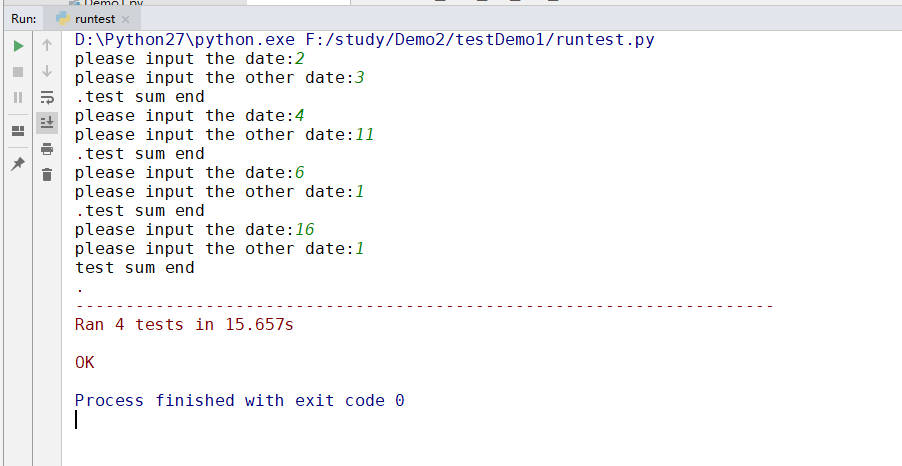Selenium 2自动化测试实战29(组织单元测试用例和discover更多测试用例)
一、组织单元测试用例
看看unittest单元测试框架是如何扩展和组织新增的测试用例
以之前的calculator.py文件为例,为其扩展sub()方法,用来计算两个数相减的结果。
#coding:utf-8
#计算器类
class Count():
def __init__(self,a,b):
self.a=int(a)
self.b=int(b) #计算加法
def sum(self):
return self.a+self.b #计算减法
def sub(self):
return self.a-self.b
因为对计算器类又新增了减法功能(sub),所以需要针对新功能编写测试用例,扩展后的test.py如下
#coding:utf-8
from Demo1 import Count
import unittest class TestSum(unittest.TestCase): def setUp(self):
a = input("please input the date:")
self.a = int(a)
b = input("please input the other date:")
self.b = int(b) def testSum(self):
self.assertEqual((Count(self.a,self.b).sum()),5,msg="the date is not Equal") def testSum2(self):
self.assertEqual((Count(self.a,self.b).sum()),15,msg="the date is not Equal") def tearDown(self):
print"test sum end" class TestSub(unittest.TestCase):
def setUp(self): a = input("please input the date:")
self.a=int(a)
b = input("please input the other date:")
self.b = int(b) def testSub(self):
self.assertEqual((Count(self.a,self.b).sub()), 5, msg="the date is not Equal") def testSub2(self):
self.assertEqual((Count(self.a,self.b).sub()), 15, msg="the date is not Equal") def tearDown(self):
print"test sub end" if __name__=="__main__":
#构造测试集
suite=unittest.TestSuite()
suite.addTest(TestSum("testSum"))
suite.addTest(TestSum("testSum2"))
suite.addTest(TestSub("testSub"))
suite.addTest(TestSub("testSub2")) #运行测试集
runner=unittest.TextTestRunner()
runner.run(suite)
上例中创建了TestAdd()和TestSub()两个测试类,分别测试calculator.py文件中的add()和sub()两个功能。通过TestSuite类的addTest()方法把不同测试类中的测试方法组装到测试套件中。
运行结果如下所示:
D:\Python27\python.exe F:/study/Demo2/testDemo1/test.py
please input the date:2
please input the other date:3
test sum end
.please input the date:4
please input the other date:5
Ftest sum end
please input the date:6
please input the other date:1
.test sub end
please input the date:20
please input the other date:10
test sub end
F
======================================================================
FAIL: testSum2 (__main__.TestSum)
----------------------------------------------------------------------
Traceback (most recent call last):
File "F:/study/Demo2/testDemo1/test.py", line 18, in testSum2
self.assertEqual((Count(self.a,self.b).sum()),15,msg="the date is not Equal")
AssertionError: the date is not Equal ======================================================================
FAIL: testSub2 (__main__.TestSub)
----------------------------------------------------------------------
Traceback (most recent call last):
File "F:/study/Demo2/testDemo1/test.py", line 35, in testSub2
self.assertEqual((Count(self.a,self.b).sub()), 15, msg="the date is not Equal")
AssertionError: the date is not Equal ----------------------------------------------------------------------
Ran 4 tests in 21.417s FAILED (failures=2) Process finished with exit code 0
通过测试结果看到,setUp()和tearDown()方法分别作用于每个测试用例的开始与结束。尝试着封装一个自己的测试类。
#test.py
#coding:utf-8
import unittest
from Demo1 import Count class Mytest(unittest.TestCase): def setUp(self):
a = input("please input the date:")
self.a = int(a)
b = input("please input the other date:")
self.b = int(b) def tearDown(self):
print"test sum end" class TestSum(Mytest): def testSum(self):
self.assertEqual((Count(self.a,self.b).sum()),5,msg="the date is not Equal") def testSum2(self):
self.assertEqual((Count(self.a,self.b).sum()),15,msg="the date is not Equal") class TestSub(Mytest):
def testSub(self):
self.assertEqual((Count(self.a,self.b).sub()), 5, msg="the date is not Equal") def testSub2(self):
self.assertEqual((Count(self.a,self.b).sub()), 15, msg="the date is not Equal") if __name__=="__main__":
# 构造测试集
suite = unittest.TestSuite()
suite.addTest(TestSum("testSum"))
suite.addTest(TestSum("testSum2"))
suite.addTest(TestSub("testSub"))
suite.addTest(TestSub("testSub2")) # 运行测试集
runner = unittest.TextTestRunner()
runner.run(suite)
创建MyTest()类的好处显而易见,对于测试类和测试方法来说,应将注意力放在具体用例的编写上,不需要关心setUp()和tearDown()所做的事情,不过,前提条件是setUp()和tearDown()所做的事情是每个用例都需要的。
二、discover更多测试用例
对上例中test.py文件的测试用例进行拆分,拆分后的目录结果如下:
Testpro/
--count.py
--testsum.py
--testsub.py
--runtest.py
文件拆分后的代码如下:
#count.py
#coding:utf-8
#计算器类
class Count():
def __init__(self,a,b):
self.a=int(a)
self.b=int(b) #计算加法
def sum(self):
return self.a+self.b #计算减法
def sub(self):
return self.a-self.b
#testsum.py
#coding:utf-8
from Demo1 import Count
import unittest class TestSum(unittest.TestCase):
def setUp(self):
a = input("please input the date:")
self.a = int(a)
b = input("please input the other date:")
self.b = int(b) def tearDown(self):
print"test sum end" def testSum(self):
self.assertEqual((Count(self.a,self.b).sum()),5,msg="the date is not Equal") def testSum2(self):
self.assertEqual((Count(self.a, self.b).sum()),15, msg="the date is not Equal") if __name__=="__main__":
unittest.main()
#testsub.py
#coding:utf-8
from Demo1 import Count
import unittest class TestSub(unittest.TestCase):
def setUp(self):
a = input("please input the date:")
self.a = int(a)
b = input("please input the other date:")
self.b = int(b) def tearDown(self):
print"test sum end" def testSub(self):
self.assertEqual((Count(self.a,self.b).sub()),5,msg="the date is not Equal") def testSub2(self):
self.assertEqual((Count(self.a, self.b).sub()),15, msg="the date is not Equal") if __name__=="__main__":
unittest.main()
#runtest.py
#coding:utf-8
import unittest
#加载测试文件
import testsum
import testsub #构造测试集
suite=unittest.TestSuite()
suite.addTest(testsum.TestSum("testSum"))
suite.addTest(testsum.TestSum("testSum2"))
suite.addTest(testsub.TestSub("testSub"))
suite.addTest(testsub.TestSub("testSub2")) #执行测试
if __name__=="__main__":
runner=unittest.TextTestRunner()
runner.run(suite)
运行结果如下:

这样的拆分带来了好处,可以根据不同的功能创建不同的测试用例,甚至是不同的测试目录,测试文件中还可以将不同的小功能划分为不同的测试类,在类下编写测试用例,整体结构更清晰。
但是这样还是没有解决添加用例的问题,此时使用TestLoader类中提供的discover()方法可以解决这个问题。
TestLoader
该类负责根据各种标准加载测试用例,并将它们返回给测试套件,正常情况下,不需要创建这个类的实例。unittest提供了可以共享的defaultTestLoader类,可以使用其子类和方法创建实例,discover()方法就是其中之一。 discover(start_dir,pattern=‘test*.py’,top_level_dir=None)
找到指定目录下所有测试模块,并可递归查到子目录下的测试模块,只有匹配到文件名才能加载。如果启动的不是顶层目录,那么顶层目录必须单独指定。 start_dir:要测试的模块名或测试用例目录。 pattern=‘test*.py’:表示用例文件名的匹配原则。此处匹配文件名以“test”开头的“.py"类型的文件,星号“*”表示任意多个字符。 top_level_dir=None:测试模块的顶层目录,如果没有顶层目录,默认为None。
现在通过discover()方法重新实现runtest.py文件的功能。
#runtest.py
#coding:utf-8
import unittest #定义测试用例的目录为当前目录
test_dir='./'
discover=unittest.defaultTestLoader.discover(test_dir,pattern='test*.py') if __name__=="__main__":
runner=unittest.TextTestRunner()
runner.run(discover)
Discover()方法会自动根据测试目录(test_dir)匹配查找测试用例文件(test*.py),并将查找到的测试用例组装到测试套件中,因此,可以直接通过run()方法执行discover,大大简化了测试用例的查找与执行。
Selenium 2自动化测试实战29(组织单元测试用例和discover更多测试用例)的更多相关文章
- Selenium 2自动化测试实战
Selenium 2自动化测试实战 百度网盘 链接:https://pan.baidu.com/s/1aiP3d8Y1QlcHD3fAlEj4sg 提取码:jp8e 复制这段内容后打开百度网盘手机Ap ...
- Selenium 2自动化测试实战3(函数、类和方法)
一.函数.类和方法1.函数在python中通过def关键字来定义函数 创建一个add()函数,此函数接收两个参数a,b,通过print()打印a+b的结果.调用add()函数,并且上传两个参数3,5给 ...
- 《Selenium 2自动化测试实战 基于Python语言》中发送最新邮件无内容问题的解决方法
虫师的<Selenium 2自动化测试实战 基于Python语言>是我自动化测试的启蒙书 也是我推荐的自动化测试入门必备书,但是书中有一处明显的错误,会误导很多读者,这处错误就是第8章自动 ...
- Selenium 2自动化测试实战34(编写Web测试用例)
编写Web测试用例 1.介绍了unittest单元测试框架,其主要是来运行Web自动化测试脚本.简单的规划一下测试目录:web_demo1/------test_case/------------te ...
- Selenium 与自动化测试 —— 《Selenium 2 自动化测试实战》读书笔记
背景 最近在弄 appium,然后顺便发现了 Selenium 框架和这本书,恰好这本书也介绍了一些软件测试&自动化测试的理论知识,遂拿过来学习学习.所以本文几乎没有实践内容,大多都是概念和工 ...
- Selenium 2自动化测试实战39(Page Object设计模式)
Page Object设计模式 Page object是selenium自动化测试项目开发时间的最佳设计模式之一,主要体现在对界面交互细节的封装. 1.认识page object优点如下:1.减少代码 ...
- Selenium 2自动化测试实战35(HTML测试报告)
HTML测试报告 显然,一份漂亮的测试报告展示自动化测试成果只有一个简单的log文件是不够的.HTMLTestRunner是python标准库unittest单元测试框架的一个扩展,它生成易于使用的H ...
- Selenium+Python自动化测试实战(2)元素定位
1.Selenium2 的原理 第一篇分享简单介绍了基于Python开发的Selenium2的环境配置,这篇主要讲一下基本用法.首先讲一下Selenium2的基本原理.基本上知道了这个东西是怎么回事, ...
- Selenium 2自动化测试实战38(整合自动发邮件功能)
整合自动发邮件功能 解决了前面的问题后,现在就可以将自动发邮件功能集成到自动化测试项目中了.下面重新编辑runtest.py文件 #runtest.py #coding:utf-8 from HTML ...
随机推荐
- deep_learning_初学neural network
神经网络——最易懂最清晰的一篇文章 神经网络是一门重要的机器学习技术.它是目前最为火热的研究方向--深度学习的基础.学习神经网络不仅可以让你掌握一门强大的机器学习方法,同时也可以更好地帮助你理解深度学 ...
- BLE 5协议栈-安全管理层
文章转载自:http://www.sunyouqun.com/2017/04/ 安全管理(Security Manager)定义了设备间的配对过程. 配对过程包括了配对信息交换.生成密钥和交换密钥三个 ...
- Go语言基础之操作Redis
Go语言操作Redis 在项目开发中redis的使用也比较频繁,本文介绍了Go语言如何操作Redis. Redis介绍 Redis是一个开源的内存数据库,Redis提供了5种不同类型的数据结构,很多业 ...
- 天线basic
1.实际应用时,按内置天线还是外置天线考虑. 内置时,净空区在 PCB 上所有层(all layer) 不能放置元件,走线和铺 GND 天线远离金属,至少要距离周围有较高的元器件 10 毫米以上: ...
- Summer training #9
A:树形DP 给出一棵树,但是它的边是有向边,选择一个城市,问最少调整多少条边的方向能使一个选中城市可以到达所有的点,输出最小的调整的边数,和对应的点 要改变的边的权值为1,不需要改变的边的权值为0, ...
- CSS基础学习-13.CSS 浮动
如果前一个元素设置浮动属性,则之后的元素也会继承float属性,我觉得这里说是继承不太对,可以理解为会影响到之后的元素,所以在设置浮动元素之后的元素要想不被影响就需要清除浮动.元素设置左浮动,则清除左 ...
- JS 循环的两种方式
// 1.for循环 for (var i = 0; i <= 10; ++ i) { console.log(i); } // 2.while循环 var i = 0; while (i &l ...
- 51nod 1172 Partial Sums V2
题目 给出一个数组A,经过一次处理,生成一个数组S,数组S中的每个值相当于数组A的累加,比如:A = {1 3 5 6} => S = {1 4 9 15}.如果对生成的数组S再进行一次累加操作 ...
- jquery clearQueue方法 语法
jquery clearQueue方法 语法 作用:clearQueue() 方法停止队列中所有仍未执行的函数.与 stop() 方法不同,(只适用于动画),clearQueue() 能够清除任何排队 ...
- java常见问题 ——运行报错1
错误1 打印乱码 相关代码 response.getWriter().print(tbItem.toString()); response.setContentType("text/html ...
